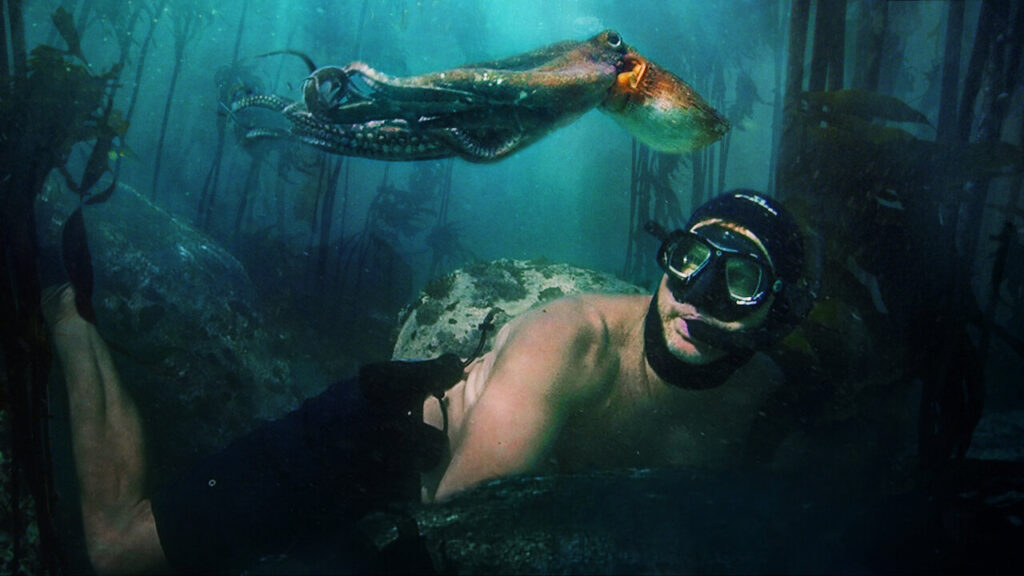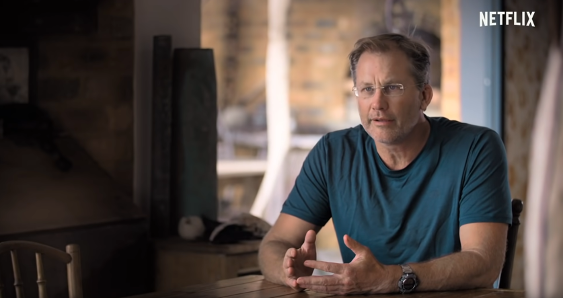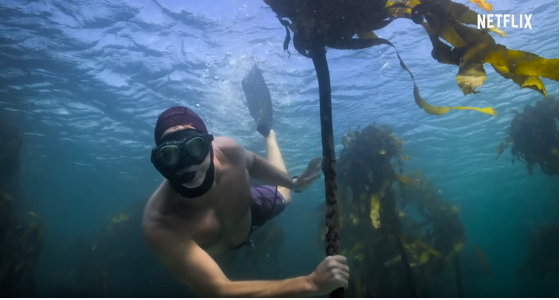
On the surface (ha), My Octopus Teacher is your typical man meets mollusk love story. But, in terms of film language (below the surface, as it were), there are some very interesting things going on: for starters, it’s almost 95% b-roll with voice-over. The story is told – and we’ll get into the filmmaking aspects of that later – by Craig Foster, a filmmaker*, whose year-long relationship with an octopus in the wild is, basically, the whole story.
* It’s interesting that he’s credited neither as a director (Pippa Ehrlich & James Reed) nor a writer (same) even though his recounting of his personal experience is the only narration/voice in the film.
There is a sit-down interview with Foster that seems to be the source for most of the voice-over narration but the interview is seen sparingly, not even introduced until several minutes in.

The interview is filmed in what seems to be his house, in a medium shot at a rather oblique angle – in other words, the eyeline is quite far off-camera; unusual these days as eyelines tend to be direct-to-camera (thank you, Errol Morris) or just off. Also, as far as I could tell, there’s just one camera/angle used on this interview; again, quite unusual for a highly-produced film where bouncing between multiple angles on a subject is the norm. What I think this carefully restrained approach to the interview says is that, as a reflection of the way Foster observed the octopus, we are observing Foster. We are not directly engaged but, rather, slightly removed and with a singular perspective on our subject. We have enough distance, in terms of eyeline, focal length and framing (Foster is almost always seen at the right edge of the horizontal frame), to dispassionately watch him as he tells his often very emotional story, like the accidental behavioral biologist that Foster becomes. This is, to me, a very strategic use of eyeline and frame that amplifies and underscores the thematic thrust of the film.
It’s another extraordinary aspect of the film that the subject, Foster, because he’s a filmmaker and was utterly alone during the actual story he’s recounting, apparently filmed much of the footage we’re watching. But, it quickly also becomes apparent that he couldn’t have filmed most of the footage in which he is seen and, as he unpacks various episodes of life at the bottom of this kelp forest, we realize that most of the incredible footage that illustrates these stories must have been filmed later.

So, attuned to the grammar of film, we start tracking the narrative building blocks; Foster approaching the water, diving in, making his way through the kelp forest, interacting with the octopus, surfacing for air, returning to the bottom, swimming home…. The story spans more than a year (he visits the octopus EVERY DAY) and there are countless versions of these same sequences. It’s a tribute to the cinematographer (Roger Horrocks) that these shore and underwater shots are so varied and compelling, even with such repetition. And the cinematography also finds ways to echo the story. For instance, to illustrate an unusual fact about octopuses – that they can “drill” a tiny hole in shelled mollusks (like sea snails) to inject poison to paralyze them – the b-roll includes a shot in which the camera is below a glass tray covered with sea shells, from which Foster removes one to examine the tiny hole, creating the effect of us peering through a hole at Foster peering at a hole.
During an extended sequence (SPOILER ALERT) in which a shark chases the octopus, the craft of taking what must have been hours of b-roll and editing a sense of the chase (menacingly tracking, hiding, turning corners, darting into the open, etc.) propelled by suspense, anticipation and other emotions from the footage is vividly on display. Less dramatically but no less powerfully, the edit cuts to beautifully evocative shots of Foster’s face in repose, swaying kelp in the current, clouds over the sea’s horizon and other “still life” b-roll to punctuate emotional beats throughout the narrative. Hats off, as well, to the beautiful sound design; sometimes melodic with bursts of distortion and what I’d describe as electronic yawing to underscore tension and suspense.
So, in addition to be a fantastic example of a film that transports viewers to a place they probably never could access, My Octopus Teacher is also a beautifully crafted piece of filmmaking that delivers a powerful, resonant story. Bravo!
If you’re interested in film language and/or filmmaking, particularly as it applies to corporate video, check out my series, Corporate Film School.
